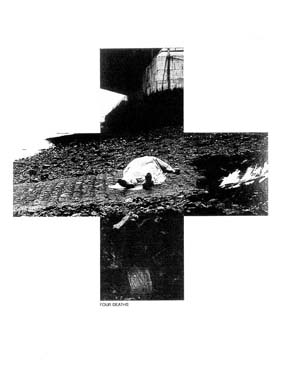How can text affect image? How can placing text upon image change the meaning? How can placing text next to an image affect its purpose? How do text and image relate? These are few of the questions you could ask about text and image and how they affect each other and the understanding of each other. For instance Joe Sternfeld looked into how photographs are interpreted first and then after information about the place and how it affects the interpretation. He described his project as seeking out a “list of places he cannot forget because of the tragedies that identify them.” The first image he took for the book collecting these haunting images called ‘On this Site’, was a crab apple tree in Central Park behind Metropolitan Museum of Art in New York, he took it in 1993. The picture is on the right side of the page and the viewer is taken in by the beauty of the tree in the morning sunlight, this perception is soon changed when they read the text on the left side of the page, reminding/telling them this is the tree where Jennifer Levin’s body was found on the morning of August 26, 1986. Then the perception of the beautiful tree in the dappled sunlight is tainted and poisoned by the ‘truth’ that actually lays before them, the scene of a murder of a young, innocent girl. It is amazing that by what cannot be known from a first glance, unless famous by the event e.g. ground zero, we have no idea what happens where, until it is pointed out to us, to when as a viewer you will never forget what happed and will forever remember that someone was innocently killed under the beautiful tree in Central Park, its ingrained in our memories much like it is in Joe Sternfeld’s. He made records of 50 places, some well known, others forgotten, but each place worth remembering.

The Crab tree where Jennifer Levin's was found murdered in Central Park
Where a black American Rodney King was beaten by 4 white policemen in a riot in 1992
Another good example of how text can influence how an image is perceived is artist John Hilliard. His photographs are actually fiction, but what he does do is takes a series of photographs of the same thing, but change where the frame is places on the image, so as he can change what the image can be perceived as, even though it is the same photograph repeated. But to engage the viewers imagination and mind, on each frame he has 1 word of type, which explains the cause of death, for instance in the picture ‘Cause of Death’ taken in 1970, he took a picture of a figure lying on a stony beach with a white sheet thrown across it. And so through changing the frame he changed he ‘cause of death’, from drowned, where he has the sea in shot, fell, to where he had a building in the background in shot, burned, with a fire in shot, and crushed, with rocks in front in shot.
The image before it was cut
The Image after it was cut



